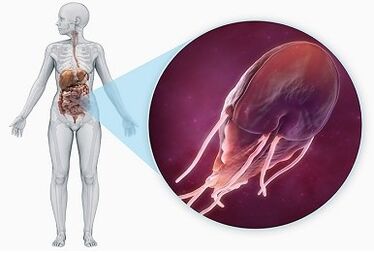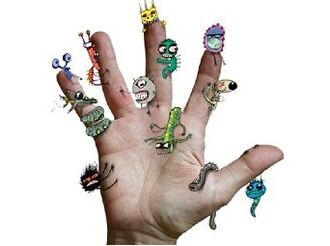Parasitism is such a form of inter -sketch interaction in which a representative of one type (parasite) partially or completely exists at the expense of a representative of another type (owner). The taxonomic list of parasitic forms that affect a person is extremely extensive
Parasites are found among arthropods, molluscs, worms, mushrooms, simple organisms, and this is not the whole list. Pathrot bacteria and viruses, from a medical point of view, are also parasites.
In this article we will talk about parasitic forms of representatives of the Kingdom of Property (Protozoa). Parasites are always an unpleasant and undesirable phenomenon, so in order to fight effectively, you need to know as much as possible about them.
Representatives of the kingdom are often called unicellular organisms. These are beings consisting of only one cell that has a constant shape, such as cilia, or capable of cytoplasmic movements such as amoeba.
Many protozoa are equipped with organs of movement, represented in the form of glands, eyelashes or pseudoopods. Their dimensions are fluctuated from microscopic to several millimeters. The body of the body contains a set of organelles that perform functions similar to the organs of more complex organisms.
The kingdom is represented by almost 15, 000 species, most of which live in the water and soil environment.
However, there are some of the unicellular organisms that prefer a parasitic lifestyle. The simplest parasites of a person can cause disease such as protozoa - sometimes taking severe forms to death. It is sometimes very difficult to get rid of a parasite in the body.
Protozoa has a protective mechanism - transferring adverse environmental conditions to an inactive state. The cell is covered with a dense, impenetrable sheath, becomes cysts and into such a non -receptive form can be a very long time. The incenate is also used by the most prolonged for their distribution.
The simplest persons of a person differ in structure, the method of introducing them into the body and causes diseases. For the best structuring of information, the main material for unicellular organisms is briefly presented in the table.
| Type caused diseases and systems of organs subject to damage | Symptoms | Ways of infection, carriers | Infecting the stage of parasite life cycle |
|---|---|---|---|
| The class is flaglated | |||
| Skin leishmaniasis is characterized by the formation of necrotic ulcers on the affected areas of the skin. Visceral leishmaniasis causes acute inflammatory reactions from the affected organs, with ulcer and bleeding. | They fall into the blood with a mosquito bite, with its saliva. Carriers - warm - strengthened animals, including humans; The carrier is a mosquito. | Promastigote (Faghellates Farfy of the body). | |
| Enteritis, allergies, asthma, depression, nervous disorders, cracks, dry skin, cholecystitis and more. | The faecal-orator path of infection through food and water. Carriers - warm - strengthened animals, including humans; Carriers - synantrop insects (flies, cockroaches). | Stage of cysts. | |
| Itching, burning in the genital area, discomfort during urination, abundant unhealthy discharge from the genitals. Complications of the development of infertility are possible. | Sexual infection; by mouth; through the rectum; When inhaled air; Parasites may be transmitted during birth from mother to child. A carrier and carrier is a person. | Each stage of the life cycle: flageltes (adults), amoeboid (intermediate, most invasive), cyst. | |
| Increasing the lymph nodes, pathological processes in the liver of the spleen, damage to the nervous system is characterized by excessive drowsiness and often a fatal result. The disease develops within two years. | Enters the blood during the insect's bite with its saliva; When pouring blood. The carrier is warming animals, including humans, a carrier - a Tseche fly (African trypanosomosis), a tritomic error (American Tripanosomosis). | Tripomastiginal stage (characteristic of membrane vibrations and movement ability). | |
| Spores class | |||
| The latent and chronic form continues asymptomatic; Symptoms of acute form are manifested by the affected organs. The most dangerous for pregnant women and newborns leads to serious disorders and congenital pathologies, to the death of the fetus. | Faecal-oral pathway of infection through unprocessed milk, meat; with insect bites; During pregnancy from mother to child. Raw and carriers are warm animals, including humans. | Stage of cysts. | |
| Increased body temperature, chills, fever, can lead to serious kidney lesions, nervous system, a fatal result is possible. | Enters the bloodstream of a person during an insect saliva bite; transmission during pregnancy from mother to child; When pouring blood. The carrier is a person, the carrier is a malaria mosquito. | Stage of sporozoitis (the ultimate form of the sexual cycle of spores). | |
| Infusoria class | |||
| The ulcer of the large intestine mucosa is accompanied by blood network diarrhea and often a fatal result is performed. | The faecal-orator path of infection through fruits, vegetables, unprocessed pork. The carrier is a pig wearing synantrop insects (flies, cockroaches). | Stage of cysts. | |
| Sarcodi | |||
| Asymptomatic and demstructive form of the form of the disease. Intestinal amoebiasis is manifested by bloody diarrhea and vomiting; Extreme amoebiasis is characterized by acute lesions of the liver, lungs and other organs. | Fecal-oral pathway of infection through vegetables, fruits, greenery; Anal sexual contact. The carrier has a warm title of animals, most often humans, carriers - synantrop insects (flies, cockroaches). | Stage of quadruple cysts. |
As a rule, for all protozoa, a very complex and multi -stage life cycle is characterized by a very complex and multi -stage life cycle, which includes a different degree of activity and functional stages of the stage.
Unicellular organisms most often occur by simple cell division into two, but some classes, along with the division, are also inherent in a more complex reproductive process with the exchange of genetic information, such as representatives of the flag class.
In addition, the life forms of protozoa are not universal for all classes. Different stages of the life cycle of parasites can be carried out in the organisms of different species of animals.
So, some of them are permanent owners, carriers of the parasite, while others play the role of carrier of infection. Also, the individual stages of the life cycle can be carried out within the same individual, but in different organs.
The symptoms of invasion depend on the stage of the parasite life cycle, the resistance of the human body, the degree of infection and location. Often, the disease is accompanied by non -specific symptoms, resulting in the diagnosis of protozoa infection is always extremely difficult.
According to recent WHO data, more than 1 billion people are infected with parasites. The worse is that parasites are extremely difficult to detect.
All these are possible signs of parasites in your body. Parasites are very dangerous, they can lead to deadly diseases. Diseases caused by parasites take chronic form.


















